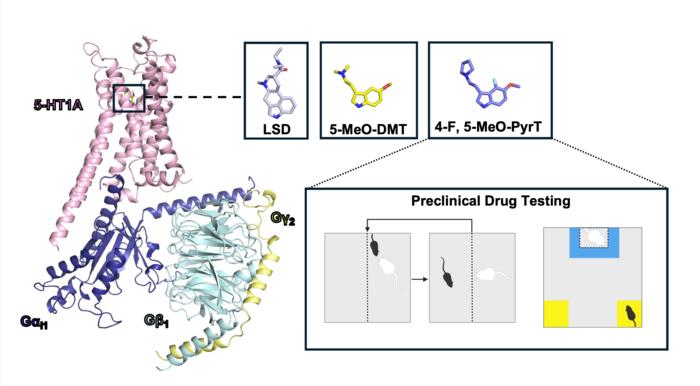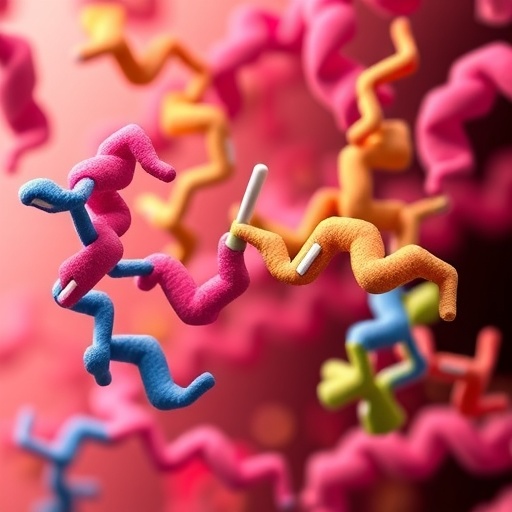Researchers at the Icahn School of Medicine at Mount Sinai have shed valuable light on the complex mechanisms by which a class of psychedelic drugs binds to and activates serotonin receptors to produce potential therapeutic effects in patients with neuropsychiatric disorders such as depression and anxiety. In a study published May 8 in Nature, the team reported that certain psychedelic drugs interact with an underappreciated member of the serotonin receptor family in the brain known as 5-HT1A to produce therapeutic benefits in animal models.

Credit: Audrey Warren, PhD candidate and Daniel Wacker. PhD, Assistant Professor of Pharmacological Science and Neuroscience at Icahn Mount Sinai
Researchers at the Icahn School of Medicine at Mount Sinai have shed valuable light on the complex mechanisms by which a class of psychedelic drugs binds to and activates serotonin receptors to produce potential therapeutic effects in patients with neuropsychiatric disorders such as depression and anxiety. In a study published May 8 in Nature, the team reported that certain psychedelic drugs interact with an underappreciated member of the serotonin receptor family in the brain known as 5-HT1A to produce therapeutic benefits in animal models.
“Psychedelics like LSD and psilocybin have entered clinical trials with promising early results, though we still don’t understand how they engage different molecular targets in the brain to trigger their therapeutic effects,” says first author Audrey Warren, a PhD candidate in the Graduate School of Biomedical Sciences at Icahn Mount Sinai “Our study highlights, for the first time, how serotonin receptors like 5-HT1A likely modulate the subjective effects of the psychedelic experience and also play a potentially pivotal role in their clinically observed therapeutic outcome.”
LSD and 5-MeO-DMT, a psychedelic found in the secretions of the Colorado River Toad, are known to mediate their hallucinogenic effects through the serotonin receptor 5-HT2A, though these drugs also activate 5-HT1A, a validated therapeutic target for treating depression and anxiety. Working closely with co-author Dalibor Sames, PhD, Professor in the Department of Chemistry at Columbia University, the team synthesized and tested 5-MeO-DMT derivatives in cell signaling assays and cryo-electron microscopy to identify the chemical components most likely to cause a drug to preferentially activate 5-HT1A over 5-HT2A. That exercise led to the discovery that a compound termed 4-F, 5-MeO-PyrT was the most 5-HT1A-selective compound in this series. Lyonna Parise, PhD, an instructor in the lab of Scott Russo, PhD, Director of the Center for Affective Neuroscience and the Brain and Body Research Center at Icahn Mount Sinai, then tested that lead compound in a mouse model of depression and showed that 4-F, 5-MeO-PyrT had antidepressant-like effects that are effectively mediated by 5-HT1A.
“We were able to fine-tune the 5-MeO-DMT/serotonin scaffold to obtain the maximum activity at the 5-HT1A interface and minimal activity at 5-HT2A,” explains senior author Daniel Wacker, PhD, Assistant Professor of Pharmacological Sciences and Neuroscience at Icahn Mount Sinai. “Our findings suggest that receptors other than 5-HT2A not only modulate behavioral effects stemming from psychedelics, but may substantially contribute to their therapeutic potential. In fact, we were pleasantly surprised by the strength of that contribution to 5-MeO-DMT, which is currently being tested in several clinical trials for depression. We believe our study will lead to a better understanding of the complex pharmacology of psychedelics that involve many receptor types.”
Indeed, researchers are hopeful based on their breakthrough findings that it may soon be possible to design novel psychedelic-derived medications that don’t possess the hallucinogenic properties of current drugs. Raising their expectations is the discovery that their lead compound – the most 5-HT1A-selective analog to 5-MeO-DMT – showed antidepressant effects without the 5-HT2A-related hallucinations.
Another near-term target for scientists is investigating the impact of 5-MeO-DMT in preclinical models of depression (given the research restrictions around psychedelic drugs, studies involving a 5-MeO-DMT derivative have been limited to animal models). “We’ve demonstrated that psychedelics have complex physiological effects that span many different receptor types,” emphasizes first author Warren, “and are now ready to build on that finding to develop improved therapeutics for a range of mental health disorders.”
Research reported in this press release was supported by the National Institute of General Medical Sciences; The National Institute of Mental Health; and the National Institute on Drug Abuse. The content is solely the responsibility of the authors and does not necessarily represent the official views of the National Institutes of Health
About the Mount Sinai Health System
Mount Sinai Health System is one of the largest academic medical systems in the New York metro area, with more than 43,000 employees working across eight hospitals, more than 400 outpatient practices, more than 600 labs, a school of nursing, and a leading school of medicine and graduate education. Mount Sinai advances health for all people, everywhere, by taking on the most complex health care challenges of our time—discovering and applying new scientific learning and knowledge; developing safer, more effective treatments; educating the next generation of medical leaders and innovators; and supporting local communities by delivering high-quality care to all who need it. Through the integration of its hospitals, labs, and schools, Mount Sinai offers comprehensive health care solutions from birth through geriatrics, leveraging innovative approaches such as artificial intelligence and informatics while keeping patients’ medical and emotional needs at the center of all treatment. The Health System includes approximately 9,000 primary and specialty care physicians and 11 free-standing joint-venture centers throughout the five boroughs of New York City, Westchester, Long Island, and Florida. Hospitals within the System are consistently ranked by Newsweek’s® “The World’s Best Smart Hospitals, Best in State Hospitals, World Best Hospitals and Best Specialty Hospitals” and by U.S. News & World Report‘s® “Best Hospitals” and “Best Children’s Hospitals.” The Mount Sinai Hospital is on the U.S. News & World Report® “Best Hospitals” Honor Roll for 2023-2024.For more information, visit https://www.mountsinai.org or find Mount Sinai on Facebook, Twitter and YouTube.
###
Journal
Nature
DOI
10.1038/s41586-024-07403-2
Method of Research
Experimental study
Subject of Research
Animals
Article Title
Structural pharmacology and therapeutic potential of 5-methoxytryptamines
Article Publication Date
8-May-2024




